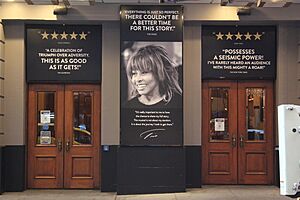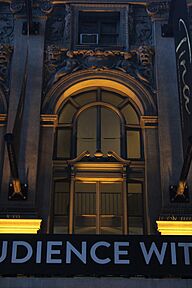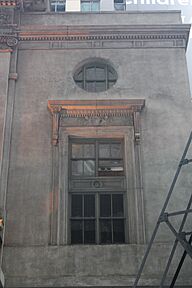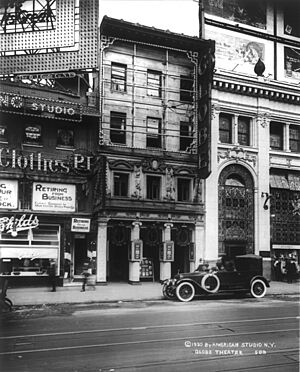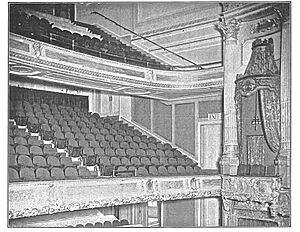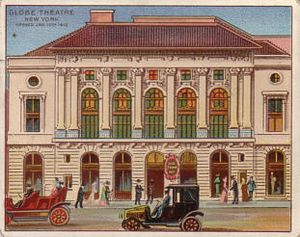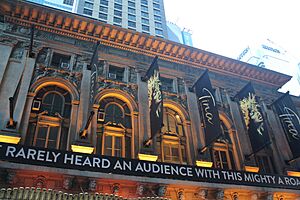Lunt-Fontanne Theatre facts for kids
|
Globe Theatre (1910–1957)
|
|

The theater as it looked in 2019
|
|
| Address | 205 West 46th Street Manhattan, New York United States |
|---|---|
| Coordinates | 40°45′33″N 73°59′9″W / 40.75917°N 73.98583°W |
| Owner | Stahl Organization and Nederlander Organization |
| Operator | Nederlander Organization |
| Type | Broadway |
| Capacity | 1,505 |
| Production | Death Becomes Her |
| Construction | |
| Opened | January 10, 1910 |
| Closed | 1931 |
| Reopened | May 5, 1958 |
| Rebuilt | 1957 |
| Years active | 1910–1931 1958–present |
| Architect | Carrère and Hastings |
| Designated | December 8, 1987 |
| Reference no. | 1350 |
| Designated entity | Facade |
The Lunt-Fontanne Theatre is a famous Broadway theater located in the Theater District of New York City. When it first opened in 1910, it was called the Globe Theatre, named after the playhouse in London where Shakespeare's plays were performed.
The theater was designed by the architectural firm Carrère and Hastings in a grand style known as Beaux-Arts. It was renamed in 1958 to honor the famous acting couple Alfred Lunt and Lynn Fontanne. Today, the theater can seat about 1,505 people and is operated by the Nederlander Organization. The beautiful front of the building, or facade, is a protected New York City designated landmark.
Design and Architecture
The Lunt-Fontanne Theatre was designed to be beautiful both inside and out. It originally had two entrances, but only one remains today.
The 46th Street Facade
The main entrance is on 46th Street. The front of the building is made of stone and has a classic, elegant look. The ground floor features several doorways set back into arches. A large sign, called a marquee, hangs over the entrance to display the name of the current show.
The upper floors are decorated with large arched windows, terraces with iron railings, and detailed carvings. You can see sculptures of female figures holding masks that represent comedy and tragedy, which are symbols of theater. The top of the building has a decorative roof and a parapet, which is a low protective wall.
The Lost Broadway Entrance
When the theater first opened as the Globe, it had a grand entrance on Broadway. This entrance was four stories tall and decorated with columns, masks, and other fancy details. It led to a long corridor that took people to their seats.
In 1957, this entrance was closed off from the theater during a major renovation. The building itself stood for many more years but was finally torn down in 2006 to make way for a new store.
Inside the Theater
The original interior of the Globe Theatre was designed in an Italian Renaissance style with colors of gold, blue, and ivory. It had an orchestra level and two balconies. One of its most amazing features was a retractable roof and ceiling. On clear nights, the ceiling could be opened to let in fresh air and show the stars.
When the theater was renovated in 1958, the inside was completely changed. The two balconies were replaced with a single, larger balcony. The new design was inspired by 18th-century styles, with blue floors and murals on the walls and ceiling. The famous retractable roof was removed during this update. Today, the auditorium has about 800 seats on the orchestra level and 700 in the balcony.
History of the Theatre
The theater has a long and interesting history, starting as the Globe and later becoming the Lunt-Fontanne.
The Globe Theatre Years (1910–1957)
The Globe Theatre was built by producer Charles Dillingham and opened on January 10, 1910. In its early years, it was known for hosting popular musicals and revues. One of its biggest hits was Chin-Chin in 1914, which ran for 295 performances. Another famous show was No, No, Nanette in 1925.
During the Great Depression in the 1930s, many Broadway theaters struggled. The Globe Theatre stopped showing live plays and became a movie theater for over 20 years. It showed many films during this time, including premieres and reruns.
A New Beginning as the Lunt-Fontanne (1958–Present)
In 1957, a group of developers bought the old Globe Theatre. They decided to turn it back into a place for live performances. The inside was completely rebuilt, and the Broadway entrance was sealed off.
The theater was renamed the Lunt-Fontanne Theatre to honor the legendary acting team of Alfred Lunt and Lynn Fontanne. They starred in the theater's first show after it reopened, The Visit, on May 5, 1958. This was their last performance on Broadway.
A year later, the theater hosted one of the most beloved musicals of all time, The Sound of Music, which was a huge success.
Famous Shows and Stars
Throughout the years, the Lunt-Fontanne has been home to many famous shows and performers.
- In the 1960s, actor Richard Burton starred in a famous production of Hamlet.
- The 1970s saw popular revivals of shows like Hello, Dolly! and Peter Pan.
- In 1981, the Duke Ellington musical Sophisticated Ladies began a successful run of over 700 performances.
- The 1990s brought a hit production of the musical Titanic.
Recent History
From 1999 to 2007, the Lunt-Fontanne was home to Disney's Beauty and the Beast. It was followed by another Disney musical, The Little Mermaid, which opened in 2008.
More recent hits at the theater include:
- The Addams Family (2010)
- Motown: The Musical (2013)
- Charlie and the Chocolate Factory (2017)
- Tina: The Tina Turner Musical (2019)
- A revival of Sweeney Todd (2023)
The theater closed in March 2020 due to the COVID-19 pandemic but reopened in October 2021. As of late 2024, the theater is showing the new musical Death Becomes Her.
Notable Productions
Here are some of the famous shows that have played at the theater over the years.
Globe Theatre
| Opening year | Name | Refs. |
|---|---|---|
| 1910 | The Girl in the Train | |
| 1915 | Stop! Look! Listen! | |
| 1918 | Ziegfeld Follies of 1918 | |
| 1920 | George White's Scandals of 1920 | |
| 1921 | Ziegfeld Follies of 1921 | |
| 1923 | Stepping Stones | |
| 1925 | No, No, Nanette | |
| 1928 | Three Cheers | |
| 1931 | The Cat and the Fiddle |
Lunt-Fontanne Theatre
| Opening year | Name | Refs. |
|---|---|---|
| 1958 | The Visit | |
| 1959 | The Sound of Music | |
| 1962 | Little Me | |
| 1964 | Hamlet | |
| 1965 | Skyscraper | |
| 1967 | How Now, Dow Jones | |
| 1970 | The Rothschilds | |
| 1972 | A Funny Thing Happened on the Way to the Forum | |
| 1973 | The Pajama Game | |
| 1978 | Hello, Dolly! | |
| 1979 | Peter Pan | |
| 1981 | Sophisticated Ladies | |
| 1984 | The Wiz | |
| 1985 | The Iceman Cometh | |
| 1994 | The Best Little ... Goes Public | |
| 1997 | Titanic | |
| 1999 | Beauty and the Beast | |
| 2008 | The Little Mermaid | |
| 2010 | The Addams Family | |
| 2012 | A Christmas Story: The Musical | |
| 2013 | Motown: The Musical | |
| 2015 | Finding Neverland | |
| 2017 | Charlie and the Chocolate Factory | |
| 2018 | Summer: The Donna Summer Musical | |
| 2019 | Tina: The Musical | |
| 2023 | Sweeney Todd | |
| 2024 | Death Becomes Her |
See also
- List of Broadway theaters
- List of New York City Designated Landmarks in Manhattan from 14th to 59th Streets


